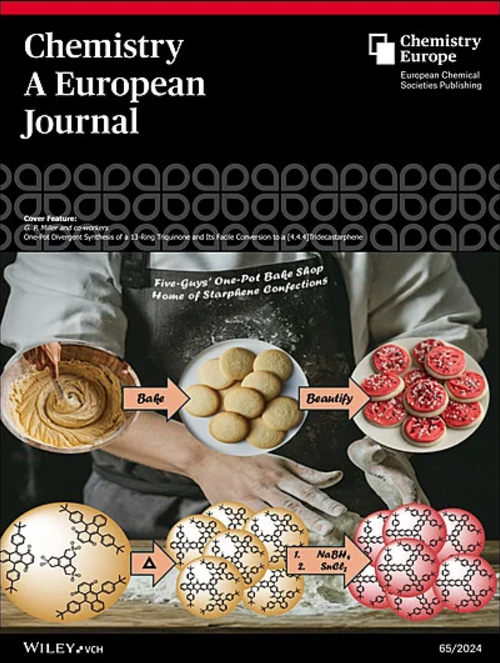利用螯合双[(二氨基)环丙烯胺]分离一系列重的零价14基四羰基铁配合物。
IF 3.7
2区 化学
Q2 CHEMISTRY, MULTIDISCIPLINARY
引用次数: 0
摘要
我们报道了利用乙烯桥接双[(二烷基氨基)环丙烯胺](bisCPI)配体LCPI来获得新的主基团E(II)卤化物配合物(E = Ge, Sn, Pb;随后用科尔曼试剂(Na2Fe(CO)4•二氧六环)还原,可以分离出一系列单原子零价四炔-四羰基铁配合物(LCPI)E(Fe(CO)4 (E = Ge (4), Sn (5), Pb(6))。化合物4 ~ 6与五羰基铁进一步反应,得到双四羰基铁配合物(LCPI)E[(Fe(CO)4]2 (E = Ge (7), Sn (8), Pb(9))。通过57Fe Mössbauer光谱和密度泛函理论计算研究了这些配合物的电子结构。本文章由计算机程序翻译,如有差异,请以英文原文为准。
![Utilization of a Chelating Bis[(dialkylamino)cyclopropenimine] to Isolate a Series of Heavier Zero-Valent Group 14 Tetracarbonyl Iron Complexes](https://img.booksci.cn/booksciimg/2025-4/102304025781779299430.jpg)
Utilization of a Chelating Bis[(dialkylamino)cyclopropenimine] to Isolate a Series of Heavier Zero-Valent Group 14 Tetracarbonyl Iron Complexes
We report on the utilization of the ethylene-bridged bis[(dialkylamino)cyclopropenimine] (bisCPI) ligand, LCPI, to give access to new main-group E(II) halide complexes (E = Ge, Sn, Pb; 1, 2, 3). Subsequent reduction with Collman's reagent (Na2Fe(CO)4 • dioxane) enables the isolation of a series of zero-valent tetrylone-tetracarbonyl iron complexes, (LCPI)E(Fe(CO)4 (E = Ge (4), Sn (5), Pb (6)). Compounds 4 – 6 were reacted further with iron pentacarbonyl to yield the bis-tetracarbonyl iron complexes (LCPI)E[(Fe(CO)4]2 (E = Ge (7), Sn (8), Pb (9)). The electronic structure of these complexes was studied by 57Fe Mössbauer spectroscopy and computationally by density functional theory calculations.
求助全文
通过发布文献求助,成功后即可免费获取论文全文。
去求助
来源期刊

Chemistry - A European Journal
化学-化学综合
CiteScore
7.90
自引率
4.70%
发文量
1808
审稿时长
1.8 months
期刊介绍:
Chemistry—A European Journal is a truly international journal with top quality contributions (2018 ISI Impact Factor: 5.16). It publishes a wide range of outstanding Reviews, Minireviews, Concepts, Full Papers, and Communications from all areas of chemistry and related fields.
Based in Europe Chemistry—A European Journal provides an excellent platform for increasing the visibility of European chemistry as well as for featuring the best research from authors from around the world.
All manuscripts are peer-reviewed, and electronic processing ensures accurate reproduction of text and data, plus short publication times.
The Concepts section provides nonspecialist readers with a useful conceptual guide to unfamiliar areas and experts with new angles on familiar problems.
Chemistry—A European Journal is published on behalf of ChemPubSoc Europe, a group of 16 national chemical societies from within Europe, and supported by the Asian Chemical Editorial Societies. The ChemPubSoc Europe family comprises: Angewandte Chemie, Chemistry—A European Journal, European Journal of Organic Chemistry, European Journal of Inorganic Chemistry, ChemPhysChem, ChemBioChem, ChemMedChem, ChemCatChem, ChemSusChem, ChemPlusChem, ChemElectroChem, and ChemistryOpen.
 求助内容:
求助内容: 应助结果提醒方式:
应助结果提醒方式:


